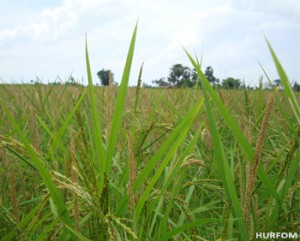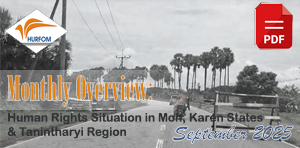Rice farmers face insect infestations alone
October 17, 2012
HURFOM: This year, insect attacks have destroyed approximately 1,000 acres of rice crops in southern and northern Mudon Township, where local farmers reported losing between one and five acres of their paddy plants. While residents said it is not uncommon to see pests eating and destroying rice stalks during the growing season, recent assaults have taken a considerable toll. Anxious farmers are assessing the blow to their annual yields, but also allege that instead of providing much needed intervention, local agriculture and irrigation authorities reap benefits from poor harvests by securing low prices from the farmers and turning a profit on the market.
“Although this situation hits us every year, the agriculture and irrigation civil servants do not work with us to manage the problem. Their duties do not seem to include giving suggestions, help, or protection, and instead they arrive just in time to persuade us to sell our rice at a low price. We cannot rely on them,” said farmer Nai Chit Aye from Hneepadaw village.
Nai Mon Sein, a 50-year old farmer from Htaung Kay village, said, “From my point of view, it’s not because of weather or fertilizer that the rice crops were ruined, it’s because we could not protect them. We are not able to afford the insecticide for the plants, so we lose our crops every year. Our lives depend on this work and if we leave the farm the authorities will confiscate the land, so we always have to worry. I grew five acres of rice and three were attacked by insects, so this year I will be in debt.”
The insects have been most destructive to short-cycle rice varieties, which are fast-growing rice plants typically used on farms near waterways or lakes. Conventional six-month rice production exposes farmers to increased risk from severe flooding or extreme weather, and these three-month crops allow cultivators to harvest early or plant again if the season’s first yield is damaged.
According to Nai Myint Sew, 60, from Kwan Hlar village, “If the rice crops had not been attacked by the insects, after paying for fertilizer, laborers, and rented machinery, the harvest could have covered our food [expenses] for the year. But this destruction suffocates us. I lost around four of my six acres of rice and I had invested around 500,000 Kyat. I think there is no way to make my money back.”
Mon State has a total of 1,352,946 acres suitable for rainy season paddy cultivation, primarily in Mudon Township and across 461,473 acres of Moulmein District and 430,000 acres of Thaton District. However, only about 800,000 acres are actively farmed due to growing limitations on resources and declining profitability.
This year, paddies were destroyed in the villages of Kwan Hlar, Hneepadaw, Yaung Daung, Abit, Kalotdot, Badow, Kwankabee, Kwanbeehtew, Kamawat, and Sein Taung, with the area around Kamawat experiencing the greatest losses. Rice produced in Mon State is distributed throughout lower Burma, including Karen State and Tenasserim Region.
Comments
Got something to say?
You must be logged in to post a comment.




















































